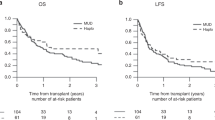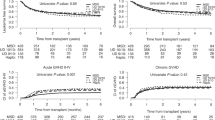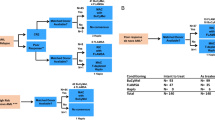Abstract
There is controversy about whether chemotherapy or an HLA-identical sibling bone marrow transplant is better treatment for adults with acute lymphoblastic leukemia (ALL) in first remission. A previous study of patients treated in 1980–1987 showed similar leukemia-free survivals with these approaches. We re-examined this issue in more recently treated patients receiving different chemotherapy. Chemotherapy subjects (n = 76) participated in trial ALL-87 of the Japan Adult Leukemia Study Group (JALSG). Transplant subjects (n = 214) were reported to the International Bone Marrow Transplant Registry (IBMTR). Treatment-related mortality, relapse and leukemia-free survival were compared after adjusting for differences in subject- and disease-related variables and time-to-treatment. Outcomes differed in persons ⩽ and >30 years of age. Five-year treatment-related mortality in persons ⩽30 years was 3% (95% confidence interval, 0–12%) with chemotherapy vs 32% (23–41%; P < 0.0001) with transplants. the difference was greater among persons >30 years, 13% (2–31%) with chemotherapy vs 57% (43–69%; P < 0.0001) with transplants. five-year relapse probability in persons ⩽30 years was 69% (50–84%) with chemotherapy vs 22% (14–32%; P < 0.0001) with transplants. among persons >30 years, 5-year relapse was 70% (53–85%) with chemotherapy vs 32% (20–45%; P < 0.0001) with transplants. leukemia-free survival at 5 years was significantly worse with chemotherapy than with transplants in persons ⩽30 years (30% (15–48%) vs 53% (44–63%; P = 0.02)) but not in persons >30 years (26% (13–41%) vs 30% (20–41%; P = 0.70)). We concluded that transplants result in more treatment-related deaths but fewer relapses than chemotherapy. Leukemia-free survival is better with transplants than chemotherapy in persons ⩽30 years of age but comparable in older persons.
This is a preview of subscription content, access via your institution
Access options
Subscribe to this journal
Receive 12 print issues and online access
$259.00 per year
only $21.58 per issue
Buy this article
- Purchase on Springer Link
- Instant access to full article PDF
Prices may be subject to local taxes which are calculated during checkout
Similar content being viewed by others
Author information
Authors and Affiliations
Rights and permissions
About this article
Cite this article
Oh, H., Gale, R., Zhang, MJ. et al. Chemotherapy vs HLA-identical sibling bone marrow transplants for adults with acute lymphoblastic leukemia in first remission. Bone Marrow Transplant 22, 253–257 (1998). https://doi.org/10.1038/sj.bmt.1701316
Received:
Accepted:
Published:
Issue Date:
DOI: https://doi.org/10.1038/sj.bmt.1701316
Keywords
This article is cited by
-
Acute lymphoblastic leukemia in first complete remission: temporal trend of outcomes in studies comparing allogeneic transplant with autologous transplant or chemotherapy
Annals of Hematology (2013)
-
Long-term outcomes of adults with acute lymphoblastic leukemia after autologous or unrelated donor bone marrow transplantation: a comparative analysis by the National Marrow Donor Program and Center for International Blood and Marrow Transplant Research
Bone Marrow Transplantation (2008)
-
Clinical and prognostic significance of cytokine receptor expression in adult acute lymphoblastic leukemia: interleukin-2 receptor α-chain predicts a poor prognosis
Leukemia (2007)
-
The role of allogeneic bone marrow transplantation in adult patients below the age of 55 years with acute lymphoblastic leukemia in first complete remission: a donor vs no donor comparison
Bone Marrow Transplantation (2004)
-
Induction therapy by frequent administration of doxorubicin with four other drugs, followed by intensive consolidation and maintenance therapy for adult acute lymphoblastic leukemia: the JALSG-ALL93 study
Leukemia (2002)



